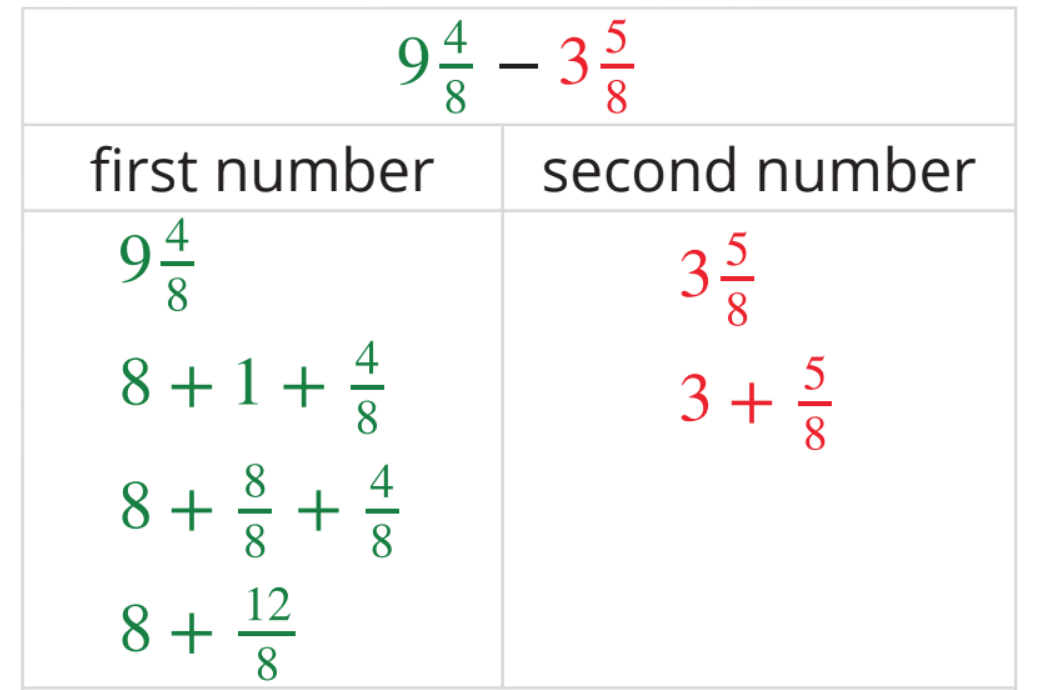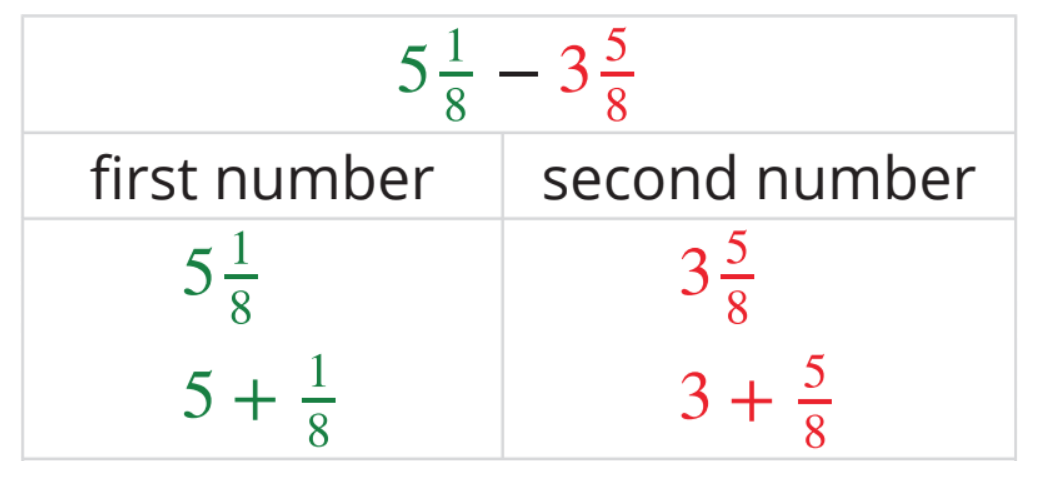Lesson 11
Subtract Fractions Flexibly
Warm-up: Which One Doesn’t Belong: Fractional Values (10 minutes)
Narrative
Launch
- Groups of 2
- Display the expressions.
- “Pick one that doesn’t belong. Be ready to share why it doesn’t belong.”
- 1 minute: quiet think time
Activity
- “Discuss your thinking with your partner.”
- 2–3 minutes: partner discussion
- Share and record responses.
Student Facing
Which one doesn’t belong?
A.
\(\displaystyle 2-\frac{3}{5}\)
B.
\(\displaystyle \frac{10}{5} - \frac{3}{5}\)
C.
\(\displaystyle 1\frac{3}{5}-\frac{1}{5}\)
D.
\(\displaystyle \frac{10}{5} - 1\)
Student Response
For access, consult one of our IM Certified Partners.
Activity Synthesis
- “Let’s find at least one reason why each one doesn’t belong.”
Activity 1: Friendship Bracelets (15 minutes)
Narrative
- draw a number line, partition it into eighths, locate \(9\frac{4}{8}\), and count back 7 spaces to the left to represent subtraction of \(\frac{7}{8}\)
- reason: “What number plus \(\frac{7}{8}\) gives \(9\frac{4}{8}\) or \(\underline{\hspace{.5in}} + \frac{7}{8} = 9\frac{4}{8}\)?”
- first subtract \(\frac{4}{8}\) from \(9\frac{4}{8}\), and the subtract another \(\frac{3}{8}\)
- first subtract 1 from \(9\frac{4}{8}\), and then add \(\frac{1}{8}\) back
Students may also use the insights they gained previously about rewriting and decomposing whole numbers to facilitate subtraction and consider whether they could be applied to subtraction of a fraction from a mixed number. When students recognize the mathematical features of things in the real world and ask questions that arise from a presented situation, they reason abstractly and quantitatively (MP2).
Supports accessibility for: Conceptual Processing, Visual-Spatial Processing, Social-Emotional Functioning
Launch
- Groups of 2
- Consider asking: “What are some things you have made, given, or received that celebrate your friendships?”
- Explain that macramé is a way of making textile by knotting and is at least a few thousand years old. The name came from the Arabic word “miqramah,” with one meaning being “ornamental or decorative fringe.”
- “Macramé bracelets are a popular way to celebrate friendships. Have you seen or made one?” (If possible, prepare a couple of bracelets—a finished one and an unfinished one—for students to see, or show images or a video of a bracelet being made.)
- “Let’s use what we know about subtracting fractions to solve some problems about friendship bracelets.”
Activity
- “Take 5 quiet minutes to work on the task, and then discuss your thinking and complete the rest with your partner.”
- 5 minutes: independent work time
- 5 minutes: partner discussion and work time
- Monitor for the different ways students go about finding differences. Identify those who write addition or subtraction expressions or equations.
Student Facing

Clare, Elena, and Andre are making macramé friendship bracelets. They’d like their bracelets to be \(9\frac{4}{8}\) inches long. For each question, explain or show your reasoning.
- Clare started her bracelet first and has only \(\frac{7}{8}\) inch left until she finishes it. How long is her bracelet so far?
- So far, Elena’s bracelet is \(5\frac{1}{8}\) inches long and Andre’s is \(3\frac{5}{8}\) inches long. How many more inches do they each need to reach \(9\frac{4}{8}\) inches?
- How much longer is Elena’s bracelet than Andre’s at the moment?
Student Response
For access, consult one of our IM Certified Partners.
Advancing Student Thinking
- “What do we know about the bracelet?”
- “What do we not know but want to know?”
- “What do we need to do to find out?”
Activity Synthesis
- Select 2–3 students who use different methods to briefly share their responses. Record subtraction and addition expressions or equations that students wrote or mentioned.
- Students will take a closer look at the same numbers in the next activity.
Activity 2: Multiple Ways to Subtract (20 minutes)
Narrative
Previously, students found differences of two fractions, including mixed numbers, using any way that made sense to them. This activity formalizes and makes explicit how such differences can be found by writing equivalent fractions and decomposing a whole number or a mixed number. When students share their responses with a partner and revise them based on the feedback they receive, they construct viable arguments and critiqe the reasoning of others (MP3).
This activity uses MLR1 Stronger and Clearer Each Time. Advances: reading, writing
Launch
- Groups of 2
- Display the four expressions in the task statement.
- “What do you notice? What do you wonder?”
- 30 seconds: quiet think time
- Share responses. If not mentioned by students, point out that finding the values of these expressions is a way to answer the questions in the first activity.
- “Let’s take a closer look at how we can subtract fractions like these without using diagrams or a context to help us.”
Activity
- “Take 2 quiet minutes to study the first set of calculations. Then, talk to your partner about what you think is happening in the calculations.”
- 2 minutes: quiet think time
- 1–2 minutes: partner discussion
- Share responses.
- “Why do you think \(9\frac48\) is decomposed into different sums?” (See Student Responses.)
- “What do the last two expressions show?” (The first one shows the \(\frac{7}{8}\) being subtracted from the \(\frac{12}{8}\), which is a part of \(9\frac{4}{8}\). The second shows the result of that subtraction being rejoined with the 8 from the \(9\frac{4}{8}\).)
- “Now it’s your turn to subtract some mixed numbers, by decomposing them, if needed.”
- “Work with your partner to complete the three incomplete calculations in the second problem.”
- 5–7 minutes: partner work time
Student Facing
Here are four expressions that you may have written about the friendship bracelets.
\(9\frac{4}{8} - \frac{7}{8}\)
\(9\frac{4}{8} - 5\frac{1}{8}\)
\(9\frac{4}{8} - 3\frac{5}{8}\)
\(5\frac{1}{8} - 3\frac{5}{8}\)
-
Here is one way to find the value of the first expression. Analyze the calculation. Talk to your partner about why \(9\frac{4}{8}\) is written as different sums.

-
Here are some unfinished calculations. Complete them to find the value of each difference.
-
Student Response
For access, consult one of our IM Certified Partners.
Advancing Student Thinking
Activity Synthesis
- Ask each student to find a new partner.
- “Explain your response to part c of the last problem to your new partner.”
- “Take turns being the speaker and the listener. If you are the speaker, share your ideas and writing so far. If you are the listener, ask questions and give feedback to help your partner improve their work.”
- 3–4 minutes: structured partner discussion.
- Repeat with at least one other partner.
- “Revise your initial response based on the feedback you got from your partners.”
- 2 minutes: independent work time
Lesson Synthesis
Lesson Synthesis
Arrange students in groups of 4. Give each group tools for creating a visual display.
Assign to each group one expression from the last problem of the last activity. Ask them to record on a visual display the calculations for finding the value of that expression.
Invite groups to share their visual displays for all to see. Ask students to analyze others’ calculations and notice how they are like or unlike their own calculations.
Select a student display for each expression or display the calculations from Student Response. Ask students to identify places where mixed numbers are decomposed or equivalent fractions are written to facilitate subtraction.
“When might it be helpful or necessary to decompose a whole number into a sum in order to subtract a fraction?” (When we are subtracting a fraction from a whole number or a mixed number there aren’t any or enough fractional parts from which to subtract.)
Cool-down: A Shorter Strip, Please (5 minutes)
Cool-Down
For access, consult one of our IM Certified Partners.


